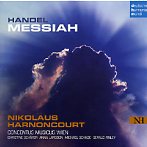No doubt, because of the conductor and esteemed performers involved, this new Messiah, recorded live in Vienna’s Musikvereinsaal in December 2004, will receive a high degree of respect and attention–and even perhaps acclaim–that may be at odds with at least some of the musical results. Going in, you know that Nikolaus Harnoncourt can be counted on to bend, twist, lurch, plod, or otherwise inject some personal interpretive quirk into a performance of a work as inviting as Handel’s Messiah. And he doesn’t disappoint.
From the beginning Sinfonia, something in his direction seems to make it difficult for his first-class orchestra to articulate rhythms clearly and cleanly–it’s surprisingly casual. The lurch appears during the runs in “And He shall purify”, and “For unto us a Child is born” must be the slowest on disc (nearly five minutes!), its measured pace belying this chorus’ inherent joy. Meanwhile, other choruses–“And the glory of the Lord” and “Glory to God in the highest”, for example–are as exciting, well-judged, and beautifully sung and played as we could hope for. But then, in “All we like sheep”, where most choirs and orchestras deliver crisp, well-defined lines, Harnoncourt opts for a kind of slurry, mushy articulation and exaggerated emphasis on the chords in the ending measures. And typically, this is soon followed by a rip-roaring “He trusted in God”–except here, the English pronunciation becomes a distraction as the choir repeatedly sings “let him deeleever him”. Overall, however, the Arnold Schoenberg Choir is outstanding (“Let all the angels of God” is another highlight), expressing the choruses with requisite energy, precision, and feeling for the style and meaning of the texts. Likewise the orchestra, which only occasionally seems confused by or just not to believe in Harnoncourt’s beat.
That leaves the soloists, and here I can easily sum up: if you’re interested in the recits and arias, the reason to hear this performance is bass Gerald Finley. He’s not only very musical and the owner of a commanding and eminently listenable voice, but his delivery is simply riveting, especially in the wonderful “The trumpet shall sound”, which may be the most impressive rendition on disc. Who can explain what tenor Michael Schade is up to? His overindulgent ornamentation and any number of other curious mannerisms seem to be saying: look at me! Some of it is just ugly–his going sharp twice during “Comfort ye my people”; his unnecessary “llllips” in the recit “All they that see Him…”; his ambiguous pitches when he tries to be extra dramatic. Well, you get the idea. Alto Anna Larsson’s throaty quality and affected enunciation sometimes seems more like a parody of alto singing than serious performing. And soprano Christine Schäfer, who has done much good work in countless other projects, sounds strained or tired sometimes and absolutely perfect at others.
And so it goes–one or two thrilling sections are followed by another marked by shaky ensemble (those dotted rhythms!) or strange tempo. Or maybe just weird interpretation, as in Harnoncourt’s “Hallelujah!”, which takes off like an overloaded cargo plane, the most laid-back opening to this powerhouse chorus I’ve ever heard. It eventually picks up and really socks a punch, filling every cubic foot of the Musikverein, but what was the point of the as-if-we’re-not-sure-if-we’re-really-happy beginning?
The live concert setting seems to have inspired everyone, the soloists especially, to sing with unusual dramatic force in places we don’t normally expect it, and I’m sure this made the concert-hall experience that much more memorable. The sound is fabulous–this is a recording you can really turn up and enjoy the room-filling effect without distortion. In between the rich, full-bodied bass and the brilliant upper treble there’s a huge middle that gives us a rare and satisfying sense of space as if we’re present in the hall.
Some fuss is made in the liner notes regarding Harnoncourt’s personal thoughts on the score–his own handwritten diagram of the work’s theological structure is included–and there’s an intriguing reference to the conductor’s study of the “autograph” score, which “reveals a number of things that printed editions cannot show.” We’re told that the autograph also indicates the use of different numbers of strings and that these markings have been “taken into account”. But we’re never told where or how these presumably important–or at least interesting–applications appear. Instead, a full seven pages are devoted to a meandering, contrived discussion that poses the question, “Who was George Frederic Handel?” Oh well. There’s a lot to enjoy here–and much that’s puzzling or just not very compelling. In other words, it’s Harnoncourt–and if this is for you, you probably didn’t read this far.
































